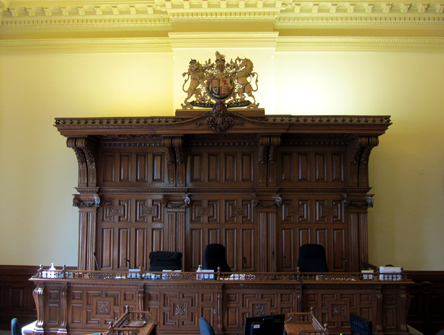When the personal is political
<p> The latest round of activism accusations threatens to chip away at the public’s perception of impartiality.</p>

You could hear the cries of “judicial activism” before the ink was dry on Carter v Canada (Attorney General). Carter, of course, was the Supreme Court’s February decision striking down the criminal prohibition on physician-assisted suicide as unconstitutional.
The definition of “judicial activism” is a political one — a vessel into which a whole bunch of preconceptions are poured — and reveals just as much about the definer as it does about the Court. For the sake of this post, let’s just say it means that the Court has reached a decision, most likely in a constitutional case, that invalidates a statutory provision and / or contradicts government policy. It has long been trendy to critique the Supreme Court as “activist.” As Emmett Macfarlane has put it, “In a lot of public discourse, complaints about activist decisions are simply complaints from someone who disagrees with a particular outcome.”
That’s certainly a good part of it.
But the conversation seems different this time. Why so?
Because this time, it feels personal.
Occasionally, allegations of judicial activism carry with them assumptions that there is a personal connection between the judges and the case. This emboldens members of the public—lawyers and non-lawyers alike—to speculate about, and critique, the judges’ true motivations.
Consider Carter. Within minutes commentators were saying that Chief Justice McLachlin “finally got her way” after dissenting in the Supreme Court’s previous decision on assisted suicide, Rodriguez v British Columbia (Attorney General). Never mind that the decision in Carter was written by “the Court” – the reasons echo the McLachlin-L’Heureux-Dubé dissent in Rodriguez, from the emphasis on section 7’s protection of dignity and autonomy over one’s own body, to the rejection of any “slippery slope” reasoning to maintain the prohibition on physician-assisted suicide.
(Another dissent had only just become the majority, in Saskatchewan Federation of Labour v Saskatchewan, which adopted Chief Justice Dickson’s dissenting reasons from Reference re Public Service Employee Relations Act (Alta) on Charter protection for the right to strike.)
The Senate Reference and the Truth in Sentencing Act appeals (R v Carvery; R v Summers) can be considered together. In both scenarios, the Supreme Court’s decisions told Parliament it could not do what it wanted to do: It could not unilaterally abolish the Senate. It could not limit credit for pre-sentence custody, at least not with inexplicit language. Reforming the Senate and limiting credit for pre-sentence custody had been key talking points and campaign messages, but there is little room left for these policies after the Supreme Court decisions.
The Nadon Reference is another example. A majority of the Court held that Justice Marc Nadon of the Federal Court of Appeal was ineligible for appointment to the Supreme Court under the statutory provisions for judicial appointments from Quebec. There was an element of awkwardness to this reference. Not only was the Court weighing in on a colleague, and in a sense reviewing and perhaps defending their own appointment processes, but the Court ended up explicitly rejecting the Prime Minister’s choice of candidate.
The personal aspect of the case was only amplified by the virtual constitutional crisis last spring, when PM Harper and Justice Minister MacKay publicly accused Chief Justice McLachlin of meddling with the Nadon appointment – judicial activism in an even more literal sense. The Supreme Court and Parliament were not just faceless institutions when the faces of the Chief Justice, Prime Minister, and Justice Minister were splashed on newspapers and news sites across Canada. Again: It felt personal.
The Canadian Bar Association and prominent members of the legal community rushed to the Chief Justice’s defence. But on a more day-to-day level, how should those of us who support the Supreme Court’s role in Canada’s constitutional scheme respond to charges of judicial activism (which are almost invariably negative)?
The suggestion is a simple one: We point to judicial independence and impartiality.
Judicial independence is a shield for judges themselves when faced with charges of judicial activism about certain substantive decisions. But it is also a bigger constitutional reason why judges must be free—and seen to be free—to reach decisions that go against the wishes of the government of the day (and even public opinion).
In 1986, in The Queen v Beauregard, then-Chief Justice Dickson described the traditional core of judicial independence as the freedom to hear and decide cases without outside influence:
Historically, the generally accepted core of the principle of judicial independence has been the complete liberty of individual judges to hear and decide the cases that come before them: no outsider‑‑be it government, pressure group, individual or even another judge‑‑should interfere in fact, or attempt to interfere, with the way in which a judge conducts his or her case and makes his or her decision. This core continues to be central to the principle of judicial independence.
He continued: “The role of the courts as resolver of disputes, interpreter of the law and defender of the Constitution requires that they be completely separate in authority and function from all other participants in the justice system.”
But judges are still in the public eye, especially in this age of social media when memes about the Chief Justice circulate online just moments after a decision like Carter comes down. The conversation about judicial activism may therefore seem more personal than it did in the early days of the Charter. And yet, it should not be allowed to strike at the legitimacy of the Supreme Court and the work of its judges.
Unless the allegations rise to the level of demonstrating bias or a reasonable apprehension thereof, we should trust that judges reach their decisions impartially. According to then-Chief Justice Lamer in R v Lippé, this is the very reason for judicial independence – judicial independence exists in order to secure impartiality:
The overall objective of guaranteeing judicial independence is to ensure a reasonable perception of impartiality; judicial independence is but a “means” to this “end”. If judges could be perceived as “impartial” without judicial “independence”, the requirement of “independence” would be unnecessary. However, judicial independence is critical to the public’s perception of impartiality. Independence is the cornerstone, a necessary prerequisite, for judicial impartiality.
The latest round of activism accusations threatens to chip away at “the public’s perception of impartiality” because it calls judicial authority into question whenever the Court reaches a controversial decision. But we cannot say that judges are impartial and independent only when we approve of the result; these guarantees are perhaps even more valuable when the Court reaches decisions that may be unpopular. Judges should not be immune from legitimate criticism, but let’s not forget the safeguards that protect them.


